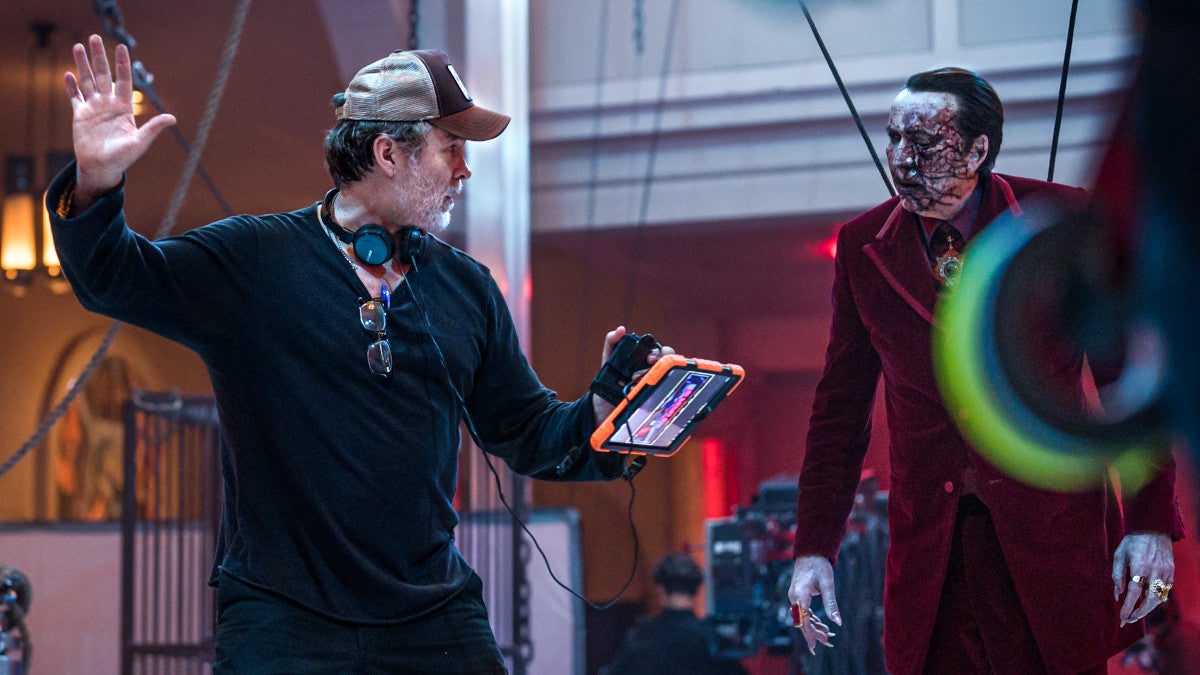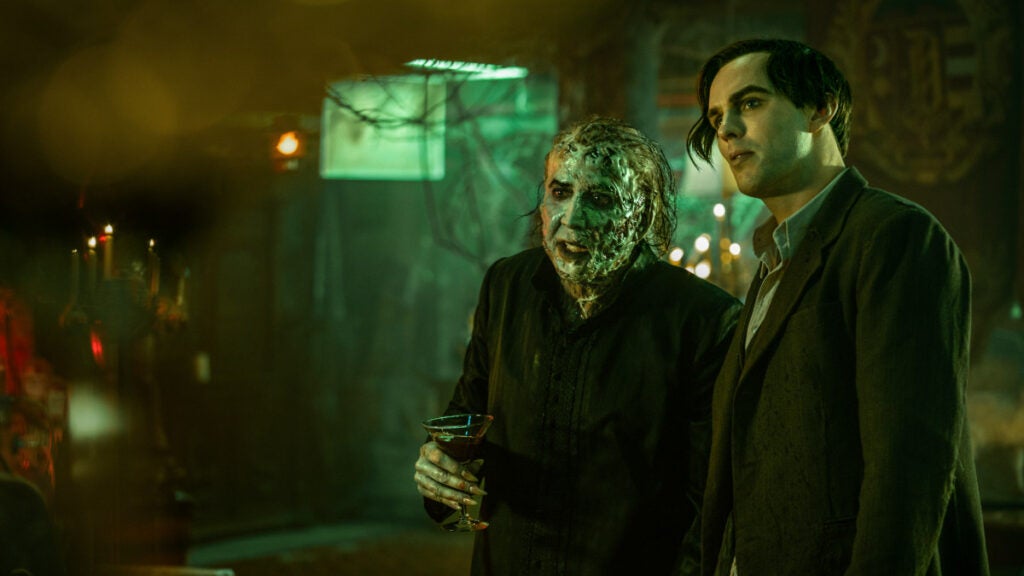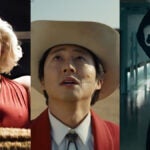
In “Renfield,” an outrageous new take on Bram Stoker’s “Dracula,” told from the point of view of the count’s perpetually put-upon manservant (played here by Nicholas Hoult), the notion of being too over-the-top is considered and then hastily breezed by. In the opening sequence alone, an ancient curse is placed on the dark prince (played, with much scenery-chewing, by Nicolas Cage); when Dracula is freed he turns into a vaporous mist and explodes a priest from the inside. Then Dracula catches on fire and is turned into a crispy skeleton.
The sequence is telling both for its bold tonal shifts and for the manic approach to action. It’s the type of scene you would say could only be devised and executed by a man well-versed in animation. (The crispy skeleton bit could have been out of an old “Looney Tunes” Roadrunner cartoon.) And you would be right. “Renfield” was brought to life by Chris McKay, who last directed the Chris Pratt alien invasion movie “The Tomorrow War” but is most known for his animation credits – he served as an animation co-director and editor on “The Lego Movie” and then directed “The Lego Batman Movie” on his own. Before that, he worked on stop-motion series like “Morel Orel” and “Robot Chicken.”
Not that he was always associated with animation.
“I started out in live-action,” McKay is quick to point out. In Chicago, he worked on music videos and commercials, along with some, um, odder gigs. “I used to shoot a lot of surgeries. I used to do a lot of healthcare training tapes for doctors and nurses. I went to hospitals and shot gallbladder removals and hernia operations,” McKay said.
This, at least, explains the verisimilitude of “Renfield’s” gore – at once garishly cartoonish and believable. McKay also confirmed that he worked as a PA on the set of Chicago legend John Hughes’ 1989 John Candy vehicle “Uncle Buck.”
His first foray into animation was “Morel Orel,” a hilarious send-up of 1960s Christian stop-motion animated series “Davey and Goliath,” created by Dino Stamatopoulos, a veteran of late-night comedy shows for Conan O’Brien and David Letterman. After that, he worked on “Robot Chicken,” a kind of stop-motion sketch show beloved for its send-up of nerdy cultural artifacts, and “Titan Maximum,” an adults-only send-up of shows like “Voltron” or “Power Rangers,” that only lasted a single season.
When Phil Lord and Chris Miller were looking for an animation director for “The Lego Movie” (since they were busy working on “21 Jump Street”), they wanted somebody who could do the animation in a “stop-motion style.” “I had been working for five or six years in stop-motion at that point,” McKay said. His job, at that point, was to help get “The Lego Movie” a greenlight.
At the time, McKay said, the greenlight for the movie had been revoked. The studio was unsure of the character’s ability to emote since they were going to be locked into the rigidity of a Lego minifigure and didn’t have the typical “squash-and-stretch” animation style usually used to convey character and personality. McKay was also tasked with showcasing that the movie was going to be for everyone, not just little kids. “I did an animatic that showed that the action scenes could be really big and expressive and basically worked to convince studio that the movie was going to be more of a mass audience movie,” McKay said.
He stayed on for the production of “The Lego Movie,” ultimately working not just as one of the animation directors but also as an animation supervisor and an editor. The movie was such a phenomenon that a suite of spinoffs and sequels was ordered, some of which were made and some which were ultimately abandoned before the franchise ran out of gas completely (in 2020, the Lego rights moved from Warner Bros. to Universal Pictures). One of the projects that got made was “The Lego Batman Movie,” which McKay directed and which was released three years after the original film.
“That’s now 10 years or so working in animation exclusively, which I would recommend to any filmmaker who hasn’t worked in animation, I would recommend that they do it because it is it is storytelling in slow motion,” McKay said. “You learn a lot about supercharging a frame with character and world-building and story information.”
McKay joked that “there’s no low-budget animation,” because you’re usually spending “millions of dollars per minute.” Still, in animation, McKay reiterates that “you really got to concentrate on the story and configure the characters and concentrate on how much information and emotion” is getting across.
McKay flirted with several projects, including a “Nightwing” live-action feature for Warner Bros. (back when the DC slate was even more chaotic). “I wanted to do ‘The Great Santini’ meets ‘Man on Fire,’ where it was a story about a guy who had a bad relationship with his mentor and kind of went off in search of his own life,” McKay said.
He also worked on a version of “Dungeons & Dragons,” to the point where he has a story credit on the new movie. (He also worked on a movie version of “Borderlands” with Craig Mazin that was ultimately directed by Eli Roth.) “It’s essentially the same,” McKay said of the new movie. “I’ve loved playing Dungeons & Dragons since I was a kid. It was one of the first things outside of movies that I was obsessed with. But I knew that if you’re going to make a big movie like this, you don’t want people to feel like they need to do homework.” The heist element came from McKay’s version. “Even some of the characters are the same,” McKay said.

Ultimately his first live-action feature was “The Tomorrow War.” Since Pratt was attached, the movie had to fit his increasingly tight schedule and became, in McKay’s words, “kind of a moving train.” Still, the complex production was aided hugely by his background in animation. “That experience working with the animators and whether it’s stop-motion or in CG was super helpful,” McKay said, in particular when bringing the marauding alien species (known as the “White Spikes” in the movie) to life. Describing a movie of that size and complexity like a “blast furnace,” the shorthand McKay developed with the animators and effects technicians made things a lot smoother. “You’ve got to be able to come to the table with solutions because they will just keep that train running if you don’t insert yourself in there,” McKay said.
With “Renfield,” McKay was drawn to the codependent relationship between Renfield and Dracula, something that he’d previously explored in “The Lego Batman Movie” between Batman and the Joker. “I always want to do something different as much as I can,” McKay said. “I want to make different movies. The main thing for me is finding something original, something novel, that’s what’s the most important. I want to challenge myself and I don’t want to be bored.”
When it came to casting Nicolas Cage as Dracula, which is undeniably genius and something that much of the marketing has hinged on, McKady admitted that he was “really nervous.”
“I knew that casting either role was going be a challenge, because you need somebody who can do comedy. You need somebody who can do the choreography and the action and can bring the dramatic chops when you need it and be vulnerable. They both needed to be vulnerable in moments. When Dracula is betrayed, he needs to be incredibly vulnerable and go through something emotional. And that couldn’t be like you’re watching somebody in quotes ‘perform’ something. You need people who were truly vulnerable and could truly do it.” McKay knew that in looking for the right person to play Dracula, “you’re talking about a handful of people.” It became, in McKay’s words “1% of 1% of 1%” when searching for an actor that an audience could get behind that a major Hollywood studio would feel comfortable fronting a $70 million, gene-splicing horror romp. “Your list whittles down really fast,” McKay said.
The idea of casting Cage came from McKay thinking, as an audience member, who would I be most excited about to play Dracula? “We’ve had umpteen interpretations of Dracula over the years. And the person I was the most excited about seeing play Dracula was Nic Cage,” McKay said.
The filmmaker admitted that Universal’s marketing department was key in getting the go-ahead to hire the actor, who has, for the past decade or so mostly appeared in independent features; his only studio movies have been providing voice work for “The Croods” (and its sequel), “Spider-Man: Into the Spider-Verse” and “Teen Titans GO! To the Movies” (as Superman, a role he was meant to play in the late 1990s for director Tim Burton in an infamously canceled project called “Superman Lives”). “He has everything you want when you cast somebody who’s a big movie star,” McKay said. “Besides the fact that he has all the tools that he comes to the table with it, he’s got chemistry with the other actors, chemistry with a camera, he’s just a joy to work around. And he’s got incredible enthusiasm for filmmaking, for creating a character.”
Over Zoom, McKay pitched Cage the movie; two weeks later Cage had a fully formed personality and accompanying voice for his iteration of Dracula. While he was onboard from the script phase, McKay remembers a moment when Cage really tuned into what the filmmaker was going for. It was during a table read. “I wanted to impress on the actors to go for it, to hold nothing back, to be to feel to be expressive,” McKay said. “It’s not just about hitting the jokes.” He put up a scene from Michael Powell and Emeric Pressburger’s vibrant 1948 classic “The Red Shoes.” It was a “feverish moment of dance.” “I said, ‘Feel free to be this unadulterated and this unselfconscious in your performance.’ And I think Cage was like, ‘Okay, got it. I know what we’re doing.’”
One of the best moments in the movie happens early on, when Renfield is recounting his relationship with Dracula. In a nod to the character’s history (and Universal’s own legacy with its classic monster line-up), Cage and Hoult are inserted into Tod Browning’s 1931 movie. “I could have done a lot more if the studio let me, I would have gone through the whole history,” McKay said. McKay and his collaborators tried to mimic the camera placement and composition of the 1931 movie and even consulted the Universal wardrobe archive for bits of original costumes (some were borrowed, some were reproduced, depending on age, fragility and the all-important copyright issues).
“The direction for Cage was never to try and be Bela Lugosi,” McKay said. “I just wanted there to be to feel like a real history and to draw on these old movies and these images that, whether you’re a fan of these movies or not ,somewhere along the line you’ve been exposed to some of these things, whether you know it or not. Most people have seen something, a poster in a dorm room or something. To me, it was about developing the relationship in a way that felt like it’d be meaningful for people who love Dracula movies and interesting and cool looking to people who didn’t.”
There’s a trailer that was released for “Renfield” recently that featured a bunch of stuff that isn’t in the movie (which has three credited editors and undoubtedly a small army of uncredited help), including a joke from that sequence at the beginning with the exploding priest that makes fun of the Catholic church. “The studio producing the movie, for some reason, had a hard time with the Catholic Church joke but the marketing department didn’t seem to have that same problem,” McKay joked.
It seems that tone was an ongoing discussion with “Renfield,” a movie whose finished version gleefully toggles between all-out horror and comedy with some romance sprinkled in there and even some gangster movie elements for good measure. There was debate about how much blood, gore and profanity should be in the movie. Much to McKay’s surprise (and overwhelming delight), test audiences responded to the very things the studio was most fearful of. “The audience really embraced all of the wild stuff,” McKay said. “They wanted Cage to be crazy, they wanted the movie to be a little over the top.” Still, he admits that “tone is always tricky.” “Because comedy is different than action is different than suspense and horror,” McKay said. “And yet, you have to kind of navigate that stuff.”
McKay embraced an iterative approach to shooting (not unlike animation!), allowing the performers, many of whom had a background in improvisational comedy like Awkwafina and Ben Schwartz, to try things out.
“I like to have a have a spectrum,” McKay said. “A spectrum of jokes but also a spectrum of emotions – how seriously are we taking this scene?” This not only allowed him to discover the tone as he went along but also provided a ”backstop” in case a scene or sequence “doesn’t pass the smell test or they get worried.” “I’m glad that ultimately [the test audiences] loved Cage so much that they that they went with stuff that was the most fun,” McKay said.
Clearly, they figured out the right approach for “Renfield” because McKay already has ideas for what he’d want to see in the sequel – Dracula would show his former employee just how much he’s moved on by recruiting other Universal Monsters to his cause. “If that was on the table, I would love to,” McKay said.
“Renfield” opens exclusively in theaters Friday, April 14.
















